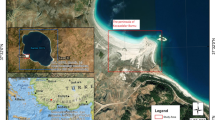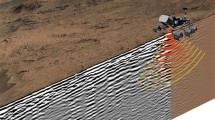Abstract
The hydrological setting of a desert plain area located in Egypt, west of Aswan city, is still not well understood, and thus, its groundwater potential remains largely unknown. Images from the ALOS/PALSAR L-band sensor have been used to detect and delineate the subsurface structures in this area. Linear, elliptical and circular polarization transformations were applied to the ALOS/PALSAR full polarimetric data by changing the orientation angle (ψ°) and elliptical angle (χ°). The circular polarization (ψ = 0° and χ = 45°) proved to be the best transformation for revealing buried faults in various strike directions, which have not been reported in the last version of the official geologic map of this area. Such derived circular polarization images were further enhanced by applying the Optimal Polarization Contrast Enhancement method. The moisture content (Ө S ) of the study sites was generally low, with an average of roughly 0.01%. The average Root Mean Square Height (hRMS) of the surface roughness was also low with 0.01 cm across all sites. The relative dielectric constant (ε r ) of the sand in the study area produced a very low value of 3.04. The effects of Ө S , ε r and hRMS on the radar backscattered signals turned out to be very low, thus providing, optimal conditions for L-band to penetrate relatively deeply. Moreover, 21 GPR profiles were acquired using 270 MHz shielded antennas to validate the radar remote sensing results. These GPR profiles reveal obvious offsets in the subsurface stratigraphy suggesting that such highly fractured zones are possibly favorable zones for groundwater accumulation.












Similar content being viewed by others
References
El-Baz, F. (2007). Use of a desert strip west of the Nile Valley for sustainable development in Egypt. Bulletin of the Tethys Geological Society, Cairo, Egypt, 2, 1–10.
Said, R. (1962). The geology of Egypt (p. 377). Amsterdam, New York: Elsevier.
Abd El-Razik, T., & Razavaliaev, A. (1972). On the tectonic origin of the Nile Valley between Idfu and Qena. Egypt Journal of Geology, 16(2), 235–245.
Youssef, M. I. (1968). Structural pattern of Egypt and its interpretation. American Association of Petroleum Geologists Bulletin, 52(4), 601–614.
Sabins, F. F. (1996). Remote sensing principles and interpretation. New York, USA: Freeman.
McCauley, J. F., Schaber, G. G., Breed, C. S., Grolier, M. J., Haynes, C. V., Issawi, B., et al. (1982). Subsurface valleys and geoarchaelology of Egypt and Sudan revealed by radar. Science, 218, 1004–1020.
Schaber, G. G., McCauley, J. F., Breed, C. S., & Olhoeft, G. R. (1986). Shuttle imaging radar: Physical controls on signal penetration and subsurface scattering in the eastern Sahara. IEEE Transactions on Geoscience and Remote Sensing, GE-24(4), 603–623.
Schaber, G. G., McCauley, J. F., & Breed, C. S. (1997). The use of multifrequency and polarimetric SIR-C/X-SAR data in geologic studies of Bir Safsat, Egypt. Remote Sensing of Environment, 59, 337–363.
Mätzler, C. (1998). Microwave permittivity of dry sand. IEEE Transactions on Geoscience and Remote Sensing, 36(1), 317–319.
Henderson, F. M., & Lewis, A. J. (1998). Principles and applications of imaging radar. Canada: Wiley.
Jenson, S., & Dominique, J. (1988). Extracting topographic structure from digital elevation data for geographical information system analysis. Photogrammetric Engineering and Remote Sensing, 54(11), 1593–1600.
Richards, J., & Jia, X. (2005). Remote sensing digital image analysis: An introduction (4th ed., p. 439). Berlin: Springer.
Conoco, Coral, & The Egyptian General Petroleum Corporation. (1987). Geological Map of South West Egypt, Scale 1:500 000.
Boerner W., Mott H., Lunenburg E., Livingstone C., Brisco B., & Brown R. J., et al. (1998). Polarimetry in remote sensing: Basic and applied concepts, chapter 5: In Manual of remote sensing, (3rd ed., Vol. 2). Principles and applications of imaging radar. London: Wiley.
Kostinski, A., & Boerner, W. (1987). On the polarimetric contrast optimization. IEEE Transactions on Antennas and Propagation, 35(8), 988–991.
Bryant, R., Moran, M., Thomas, D., Holifield, C., Skirvin, S., Rahman, M., et al. (2007). Measuring surface roughness to parameterize radar backscatter models for retrieval of surface soil moisture. IEEE Transaction of Geoscience and Remote Sensing Letters, 4, 1–6.
Wyatt, D. E., & Temples, T. J. (1996). Ground penetrating radar of small-scale channel joints and faults in the unconsolidated sediments of the Atlantic Coastal plain. Journal of Environmental Geology, 27, 219–225.
EGSMA, NARSS, UNDP, & UNESCO. (2005). Geomorphologic map of Aswan Quadrangle, Egypt. Executed by UNESCO Cairo Office, EGY/97/011, scale 1:250.000.
EGSMA, NARSS, UNDP, & UNESCO. (2005). Geological Map of Aswan Quadrangle, Egypt. Executed by UNESCO Cairo Office, EGY/97/011, scale 1:250.000.
Njoku, E.G. (1976). Microwave remote sensing of near-surface moisture and temperature profiles. PhD Thesis, Massachusetts Institute of Technology.
Schmugge, T. J. (1980). Effect of texture on microwave emission from Soils. IEEE Transaction of Geoscience and Remote Sensing, GE-, 18(4), 353–361.
Topp, G. C., Davis, J. L., & Annan, A. P. (1980). Electromagnetic determination of soil water content: Measurements in coaxial transmission lines. Water Resources Research, 16, 574–582.
Mätzler, C., & Murk, A. (2010). Complex dielectric constant of dry sand in the 0.1 to 2 GHz range. Research Report No. 2010-06-MW.
Ulaby, F. T., Moore, R. K., & Fung, A. K. (1982). Microwave remote sensing; active and passive: v.2, radar remote sensing and surface scattering and emission theory (pp. 457–1064). Reading: Addison-Wesley.
Acknowledgments
The authors would like to thank the Japan Aerospace Exploration Agency (JAXA) for providing the ALOS data as part of the ALOS user agreement (ALOS-RA-81). This work is being funded by the US—Egypt Science and Technology Joint Fund in cooperation with NSF and STDF under Project Award # 1004283 and # 1975, respectively.
Author information
Authors and Affiliations
Corresponding author
Rights and permissions
About this article
Cite this article
Gaber, A., Koch, M., Helmi Griesh, M. et al. SAR Remote Sensing of Buried Faults: Implications for Groundwater Exploration in the Western Desert of Egypt. Sens Imaging 12, 133–151 (2011). https://doi.org/10.1007/s11220-011-0066-1
Received:
Published:
Issue Date:
DOI: https://doi.org/10.1007/s11220-011-0066-1




